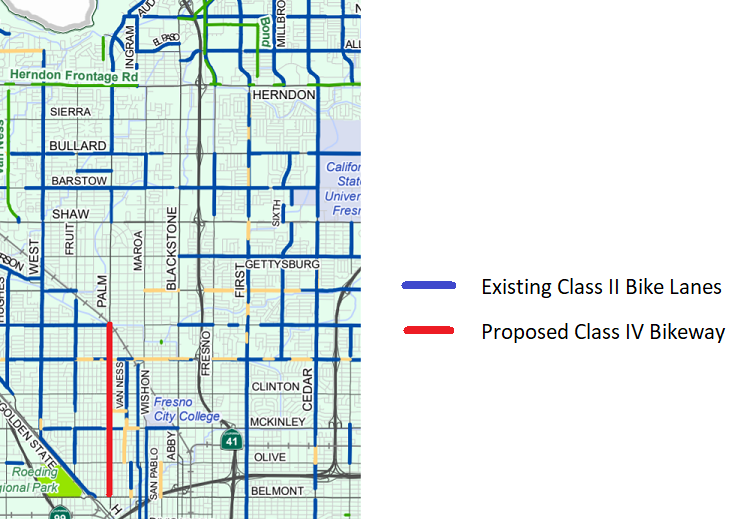Spring is just around the corner, and daylight saving time will provide more light for early evening rides. May is Bike Month and will soon be here, and FCBC is gearing up for our 2nd Annual Bike Month Movie Event.
In this month’s Newsletter:
- Bike Café is on Tuesday, March 8, with new City of Fresno Active Transportation Program Coordinator Carla Gonzalez and Scott Sehm, City of Fresno Public Works Manager, who will present an update on upcoming Class IV separated bikeway projects and the Midtown Trail.
- In May, FCBC will be screening The Soul of a Cyclist, an award-winning documentary, and we will be joined by director and filmmaker Nuno Tavares via Zoom on May 22.
- In our ongoing series on bicycle infrastructure, we discuss Class I bikeways.
- The next Fresno Bike Station Fix Your Own Bike event is on Sunday, March 13 from 11:00 am to 3:00 pm in the Tower District.
- The next chapter from the pending book by Juan Flores on bicycling in Fresno describes the Palm Avenue crosstown ride from Belmont Avenue to the San Joaquin River.
- The next Board meeting is on March 17.

FCBC Bike Café
The monthly virtual Bike Café allows FCBC members and others to socialize and discuss bike-related topics of interest. For this month's Bike Café, we are excited to introduce Carla Gonzalez, the new City of Fresno Active Transportation Coordinator, who will discuss her new role, and Scott Sehm, City of Fresno Public Works Manager, who will present an update on upcoming Class IV separated bikeway (cycle track) projects on Palm, Belmont, and Barstow Avenues and the long-awaited Class I multipurpose Midtown Trail.
Register here to get the Zoom link. If you have questions about using Zoom, registration for the event, or any other questions, email us events@fresnobike.org.
If you missed the Bike Café last month on Vision Zero and what it may mean for Fresno, the recording and other videos can be found on the FCBC website.
May is Bike Month Movie Event: The Soul of a Cyclist
You are invited to the May is Bike Month Movie Event!
If you have ever dreamed of traveling the world by bicycle, this is the film for you. This year we are excited to be screeningThe Soul of a Cyclist, an award-winning documentary that celebrates how bicycling brings people together, inspires joy, builds vibrant communities, and leads to a happier, more fulfilled life. Bicycles are amazing!
Enjoy a picturesque journey from the rolling hills of Lisbon, Portugal to the tweed-filled streets of London, England, and meet all the charmingly quirky people who share a love of bicycles and bicycling. The movie is 73 minutes with English subtitles.
Nuno Tavares, director and filmmaker, will be joining us from Portugal via Zoom for Q & A. We are thrilled because there is an 8-hour time difference between Portugal and California. Register for the event here.
Bicycle Infrastructure: Class I Bikeways
Class I bikeways are also known as bike paths or shared-use trails. They are often considered the most desirable type of bikeway for a low-stress network because they have an exclusive right-of-way for use by pedestrians and bicyclists and are separate from roadways and have minimal vehicular crossings. However, they can be expensive to construct in existing built environments, and they can be expensive to maintain.
All bicycle facilities must conform to the standards of the CaltransHighway Design Manual, Chapter 1000. Class I bikeways may be used in urban or rural and high or low-speed environments. The minimum width for a two-way Class I bikeway is 8 feet, with 10 feet preferred. A two-foot shoulder of asphalt or other all-weather material is also required. The minimum distance from the edge of bikeway to a fixed object, such as a sign post or light pole, is to be two feet. This distance may include the shoulder width, and a minimum distance of 3 feet should be provided where feasible. Bollards are often placed at the centerline of trails where they intersect with streets. They are permitted, but they must provide 5 feet of paved clearance between obstacles.
Class I bikeways are typically paved with asphalt. While concrete may require less maintenance than asphalt, the expansion joints and settling of panels may not make for a comfortable bike ride. When trails become crowded with too many users, it may be possible to separate bicyclists from other users by having separate paths. Lighting of trails is not required, but they are an important element to make users feel safe.
Many of the trails in Fresno County have been constructed in decommissioned railroad right-of-way, commonly known as rails-to-trails projects. In new growth areas, developers are often required to construct or contribute towards the construction of trails that are adopted in the Circulation Element of the General Plan. The Fresno Midtown Trail will be within Fresno Irrigation District right-of-way, and one of the reasons for the length of time to get the project to construction is addressing the maintenance and liability concerns.
Because trails typically are used by both pedestrians and bicyclists, etiquette is important to prevent conflicts, with bicyclists letting their presence known by ringing a bell or calling out “on your left” while passing others. Bicyclists should also travel at safe speeds, with high travel speeds best left for bicycling in the roadway.
If you see a need for a bicycle facility near where you live, work, or recreate, send your locally elected official your suggestion at the FCBC Take Action page.
Fresno Bike Station FYOB Event
The next Fresno Bicycle Station Fix Your Own Bike event is scheduled forSunday, March 13 between 11:00 am and 3:00 pm at the Van Ness Village Vendor Fair, located at 1440 N. Van Ness Avenue. The Fresno Bike Station is sponsored by FCBC and allows bike owners to learn how to repair their own bikes with help from experienced mechanics, including FCBC member Julie Congi and Tower Velo owner Chris Eacock.
Upcoming Book on Bicycling in Fresno
Below is the seventh chapter in the book that FCBC Board Member Juan Flores is writing on bicycling in Fresno. The chapter is on the upcoming Palm Avenue bikeway, which is also one of the topics of this month’s Bike Café. Juan welcomes any comments, corrections, and constructive criticism at juan@fresnobike.org. Previous chapters can be viewed on the FCBC website.
The Palm Avenue Crosstown Ride

The City of Fresno received a $1.4 million Active Transportation Program Quick Build grant to install Class IV separated bikeways, also known as cycle tracks, on segments of Palm Avenue and Belmont Avenue. After the protected bikeways are installed on Palm Avenue, the proposed Palm Avenue crosstown ride will begin on Belmont Avenue and wind its way through established neighborhoods such as the Tower District and the Fresno High School neighborhood and end at Dakota Avenue. Ideally it will connect with the San Joaquin River Parkway and with other bike paths in Clovis.
There are few protected bikeways in Fresno, and hopefully this is the beginning of things to come. The bikeway will offer riders added protection from motorists and will stretch nearly 13 miles from downtown Fresno to the San Joaquin River Parkway if and when it is completed. Whether it gets completed depends on getting additional funding, County sign-off on a stretch of Palm Avenue in a County island between Shields and Shaw Avenues, and the concurrence of residents along the proposed route.
As envisioned, the project would reduce vehicular travel lanes from four to two and a center turn lane. The older streets in Fresno tend to be narrower and, thus, do not provide enough room for the creation of a protected bikeway for bicyclists without removing travel lanes. The bikeway will have flexible posts every 8 feet that will separate bicyclists from traffic. Critics of the bikeway say that reducing the number of lanes will severely restrict traffic and reduce traffic speed, but proponents of the bikeway say that reducing traffic speed will make the route safer for bicyclists and pedestrians.
“Cities across the state offer cyclists protected bikeways that add an extra layer of protection for riders and drivers,” City Councilmember Esmeralda Soria said in a news release. “As the fifth-largest city in the state of California, Fresno should already be at the forefront in providing a safe experience for our cyclists. This project will connect the north and south parts of our city and will open the doors to more protected bikeways in other areas.”
The jurisdictional issues notwithstanding, there is much agreement in Fresno regarding the value of providing a bikeway that will connect the downtown area to the richness of the San Joaquin River.
Next Board Meeting
Break out the shamrocks and join us at the next Board meeting on Thursday, March 17 at 7:30 pm via Zoom. Everyone is welcome to join the virtual meeting. If you would like to participate in the meeting, register here, and you will immediately get the Zoom link.
Membership
If you are not yet a member of FCBC or need to renew, please visit https://fresnobike.org/join to become a member or renew your membership.
Have a comment or suggestion? Contact us at info@fresnobike.org
